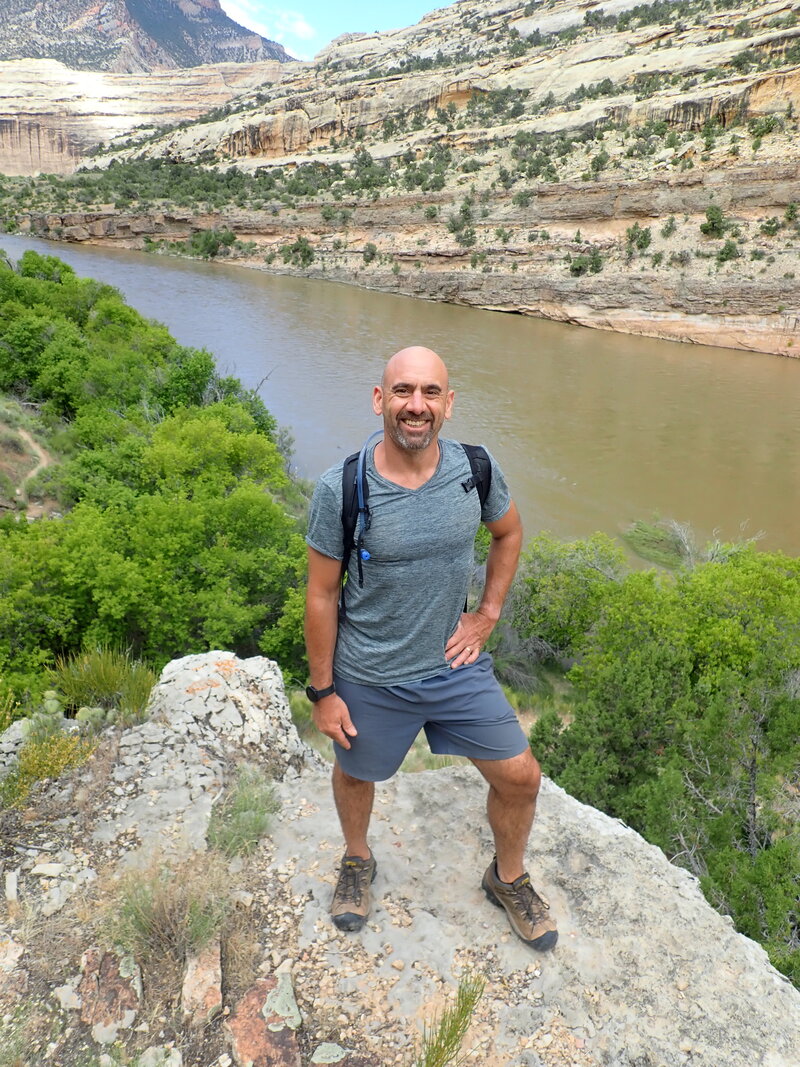From a background in riparian ecology, I approach my research in ecohydrology primarily from the ‘eco-‘ side. To me, ecohydrology comprises not only the movement of water through the biosphere, but also water’s influence on dependent biotic communities, both aquatic and terrestrial. In riparian ecosystems, the influence of flowing water and what it carries—sediment, solutes, organic matter—is manifest in many processes: the global and local distribution of vegetation types, traits and life history strategies; critical demographic processes such as seedling recruitment and adult mortality from drought and floods; ecophysiological function and growth; and riparian community dynamics and succession, to name a few.
What are your undergraduate and graduate degrees in?
I majored in Architecture at Yale University, and earned my MS and PhD in Environmental Science, Policy and Management from UC Berkeley. With stints in design firms, high-school teaching, non-profits and environmental consulting firms in between, my path has been anything but linear.
How did you arrive at working in/thinking about ecohydrology?
I came to ecohydrology from an applied and practitioner’s perspective. After my undergrad degree I worked for five years in an urban youth conservation corps in Oakland, California as a crew supervisor and project coordinator. Working with young adults on stream restoration and flood channel maintenance projects made me curious to ‘pop the hood’ on these ecosystems and understand their underlying mechanisms. I went to grad school to study riverine and riparian ecosystems and the reciprocal interactions between their physical and biological components. My doctoral co-advisors were critical in helping me retool my background in design to an ecosystem perspective. Joe McBride inspired me to observe how streams and riparian zones interact and change over time, and John Battles taught me how to translate those observations into research questions to test using rigorous quantitative approaches.
Since then I have worked in water-limited ecosystems in the southwestern U.S. and southern Europe, as well as water-rich regions like the Adirondacks in New York State. Wherever there is wood and water, there are always fascinating questions to pursue. In drylands, I think about how human drivers such as water infrastructure (dams and diversions), land use and climate change interact to threaten the stability of critical riparian habitats. In the Northeast, my students study how ecosystem engineers such as beaver and muskrat transform not only the region’s hydrosystem, but also the structure, function, and biodiversity of adjacent forests and wetlands. I feel very lucky to work in these environments that are so important for both people and nature.
What do you see as an important emerging area of ecohydrology?
One emerging area is how to disentangle the effects of multiple, interacting stressors on water-dependent ecosystems. Riparian areas in drylands, for example, are subject to an increasingly damaging mix of longer and more frequent droughts, declining groundwater, changing fire regimes, non-native species invasions, new pests and diseases, and impacts from human land and water use. New research seeks to understand the influences of these multiple stressors on ecosystem structure and function, and whether the effects are additive, synergistic, antagonistic (mutually-canceling), and/or non-linear (e.g., thresholds and hysteresis). Riparian ecosystems, because of their complexity and critical functions and services, need new frameworks and models for quantifying these complex dynamics and predicting future trends.
Another promising area is the development of new sensors and monitoring tools with increasing resolution and their application to ecohydrological processes. The proliferation and greater usability of remote sensing approaches such as hyperspectral imagery, LiDAR and UAVs is allowing us to gain a more refined understanding of how plants express ET and water stress at a landscape scale. The smaller pixel sizes and denser time series of these new platforms promise to transform how we understand riparian zone response to physical drivers, especially on low-order streams, which are too small to effectively monitor at the previously standard 30m pixel scale. At the scale of individual trees, low-cost sap flux and other sensors, combined with emerging dendroisotope techniques help us better understand plant responses to short and medium climate events. combining these technologies to get an integrated view of vegetation sensitivity to climate and other drivers at multiple scales is really exciting, and allows us to ask new questions and make better predictions with mechanistic understanding.
Do you have a favorite ecohydrology paper? Describe/explain.
I don’t have just one seminal paper that inspired my scientific interests, but several stand out at key points in my career. When I first started studying Mediterranean ecosystems, Nate Stephenson’s 1990 paper Climatic Control of Vegetation Distribution: The Role of the Water Balance (Am. Nat. 135: 649-670) made me appreciate how seasonal timing of water availability, not just annual surplus and deficit, is a critical control on vegetation distribution, composition, and ecosystem productivity.
Starting with my doctoral research and ever since, Stew Rood’s papers have been very influential in my thinking about hydrological controls on riparian trees, both in terms of their ecophysiological responses (Tree Physiology 23:1113-1124) and how their life history timing and traits interact with fluvial processes (Wetlands 18:634-645). He, along with several other colleagues working on aridland rivers (collectively dubbed the “Dead Cottonwood Society”) continue to inspire and challenge my understanding of riparian ecosystems’ function, vulnerability and resilience in this era of global change.
What do you do for fun (apart from ecohydrology)?
At play as at work, I love water in all its phases. Swimming and skiing are two of my favorite pastimes and sustain me across all the seasons. In summer I love open-water swimming in Central New York’s many beautiful lakes, and in winter, nordic and telemark skiing are my go-to activities. At this time of year I enjoy skate-skiing along the Old Erie Canal near Syracuse where I can marvel at both the natural hydrosystem and humans’ amazing feats of engineering before the age of steam. As a family, my wife, kids and I love traveling to new places together and immersing in new languages, cultures and cuisines.

 RSS Feed
RSS Feed